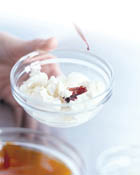
Prepared Foods' R&D Conference held in September 2005 featured practical, technical seminars designed to further educate bench-level R&D personnel on solutions to specific application challenges. Following are excerpts on topics impacting the dairy foods industry, including omega-3 fortification, sweetener systems and emerging nutrients.--Eds.

Omega-3 Fortification in Dairy Foods
Omega-3 fatty acids are a healthy food ingredient providing health benefits in a wide range of areas. Sharon Spurvey, technical support specialist for Ocean Nutrition Canada, provided information on the need and means to fortify dairy products, including yogurt with omega-3 fatty acids.Omega-3 fatty acids are found in marine and plant sources. Marine sources are eicosapentaenoic (EPA) and docosahexaenoic acids (DHA). Thousands of published papers attest to the health benefits of EPA and DHA in regards to cardiovascular disease (CVD), brain function and development, immune function, arthritis, skin and hair health.
Many Americans do not eat fish and, therefore, have inadequate intakes of omega-3 fatty acids. FDA, USDA, the American Heart Association and others have recommended consumption of EPA/DHA at 500mg per day. Fortifying foods with fish oil will help Americans achieve that recommendation.
Due to high consumption and acceptance as a healthy food, dairy products are excellent candidates for adding omega-3 fatty acids. Milk has been used as a fortification vehicle for vitamins A and D, so consumers should accept the addition of healthy ingredients to milk. Dairy products already have health benefits associated with them, including prevention of osteoporosis, hypertension, obesity, type 2 diabetes, CVD, stroke, cancer and dental health.
Issues surrounding omega-3-enhanced dairy products are primarily formulation challenges: How much to add? How is the product labeled? Are there allergen concerns? What claims can be made on the label? What about contaminants?
Microencapsulated fish oil has solved a main formulation challenge--the flavor/odor problem--allowing its addition to a wide variety of foods.
There is no established recommended daily amount for EPA/DHA, but delivering 50mg to 100mg per serving in a variety of foods will help people reach the 500mg/day amount proposed by FDA, AHA and others.
Refined, bleached and deodorized fish oil typically is considered non-allergenic, but as with any other ingredient, “fish oil” should be listed on the ingredient statement. If the fish oil ingredient is made from fish that contains low levels of contaminants and is processed by molecular distillation, which removes heavy metals and PCBs, consuming purified fish oil is safer than consuming fish.
“Formulation of Omega-3 Powder into Dairy Foods,” Sharon Spurvey, Ocean Nutrition Canada, sspurvey@ocean-nutrition.com .
Ingredient Functionality: Sweetener Systems
Polyols or sugar alcohols are derivatives of traditional sugars and carbohydrate polymers. Produced through enzymatic or catalytic hydrogenation, polyols are excellent sugar substitutes that provide a low-glycemic and low-caloric option for diabetic and diet-directed foods. Peter Jamieson, manager of applications research at SPI Polyols, provided information on the recent technological advances in the area of polyols.Polyols are nutritive sweeteners that provide excellent bulk in sugar replacement where high-potency sweeteners do not. Diabetics have been using them for years. Recent advances have allowed a wider variety of polyols available to the product developer, opening the door for greater taste, texture and overall quality of “reduced-sugar” and “no-sugar-added” foods. Although polyols have proven to be a great tool to the product developer in these applications, they often are misunderstood and used inappropriately.
“Polyols,” as a term, currently encompasses a group of nine products. This can be subdivided into the mono-”saccharides” erythritol, mannitol, sorbitol and xylitol; the di-”saccharides” isomalt, lactitol and maltitol; and the polymeric mixtures maltitol syrups and polyglycitol (HSH) syrups.
While this group shares a number of similar properties, their chemical and physical differences offer a wide choice of direction in application. When choosing a polyol, it is recommended developers pick one similar in molecular weight to the carbohydrate being replaced. Considerations include browning (polyols do not participate in the Maillard reaction); solubility, which impacts texture, mouthfeel and shelflife; and the laxative effect, which occurs at differing levels of consumption for the various polyols.
Knowledge of their properties and applications can result in great-tasting, sugar-free, reduced-calorie, reduced-glycemic and/or non-cariogenic food products. This knowledge also can be applied to shelflife control in terms of water activity, control of freeze point, crystallization control, texture control and color stabilization.
“Polyols: Issues and Opportunities,” Peter Jamieson, SPI Polyols, pjamieso@spipolyols.com.